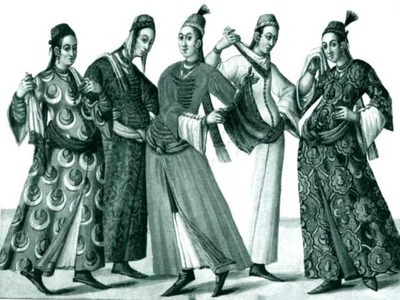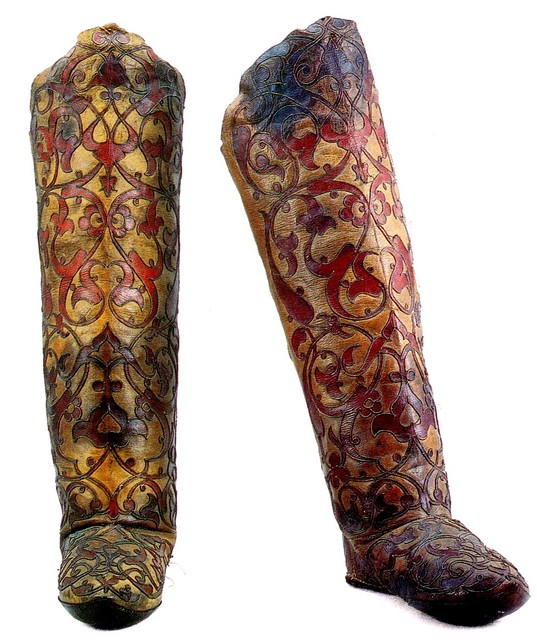Category:Ottoman Garb
For the purposes of this article we have combined the major pieces and styles of clothing from Middle east, Persia, and the Ottoman empire.
History
The Ottomans (also spelled Osmanli, Osmali) The Ottoman Empire ruled Turkey and parts of Southeastern Europe, the Middle East, and North Africa from 1299 to 1922, although it is best known for its Golden Age during the 16th Century under the rule of Suleiman the Magnificent (also Suleyman). At its height, the Empire dominated both the Silk Road trade route and the Mediterranean, spread Islam throughout the region, and blended Seljuk Turk, Persian, and Greek influences to develop, among other things, a completely new style of architecture. Stunning examples of this include the Green Mosque in Bursa and the Topkapı Sarayı (Palace) in Constantinople. The latter survived the centuries and is now a museum, which houses an extensive collection of Ottoman artwork. Unlike most other cultures, the Turks did not appear to sculpt. Instead, they boasted of luxurious fabrics (velvets, brocades, and silk) and pottery & ceramic tiles. Painted miniatures existed as well, dominated by scenes of the Sultan and his men hunting, fighting, working, or in court. These miniatures depict the vibrant colors and distinctive shape of Turkish clothing: a bell-like shape, tight through the torso with side gores from the waist to the floor. Paintings? Didn’t the Koran prohibit the depiction of human figures? Actually, it was Muslim law, not Koranic doctrine, which enforced the tradition as a way of preventing idol worship. Yes, most court-approved painters restricted themselves to elaborate floral and geometric designs. Some, however, unofficially and quietly did portraitures, especially of the Sultan and his court.
Ottoman Garments
- Tarpus: Tall pointed or pillbox-like hat.
- Yasmak: Two-piece veil tied over the hat and around the lower face, worn while outside the home; made of linen, cotton, or silk.
- Kaftan (also caftan): Loose outer coat with wide sleeves, made of elaborate and sumptuous velvets and silks, often lined with fur; worn for ceremonial occasions.
- Ferace: Dark, loose, wool overcoat, sometimes lined with fur, worn when outside during cold weather.
- Yelek: Slightly fitted, crotch-length coat with elbow- length or wrist-length sleeves, made of silk and lined with cotton, worn over the entari during cold weather.
- Entari (enteri, anteri, antari): Medium-weight, A-shaped or bell-shaped coat, fitted to the waist and shaped with side gores and an overlapping front gore, generally reaching to the floor. The neckline was either round or a V. It was closed down the front with small buttons & loops or long frogs; however, it was often depicted unbuttoned from the neckline to the chest and from the waist to the floor. Sleeves were most often wide to the elbows although some are narrow to the wrists (showing the Persian and Venetian influence). Very occasionally, you see extremely long maunche-like sleeves with slits, as in many Persian outfits. Made most often of silk, lined with cotton. There was rarely any trim, but the inside edge was faced with silk.
- Hirka (chirka): Very fitted thigh-length underjacket, worn over the gomluk. May be sleeveless, with wide elbow-length sleeves, or long, wrist-length narrow sleeves.
- Kusak: Soft, wide sash or girdle worn on top of the entari.
- Uckar: Leather or metal belt, decorated with gold, ivory, or silver plaques, semi-precious stones, and beads.
- Gomlek (gonluk, goomluk): Lightweight, sheer, long- and narrow-sleeved, round-necked undershirt. Wide, long sleeves seen in late period. Appears to be generally white cotton, silk, or linen. Some paintings show what appears to be embroidery or even tablet weaving along the seams and hem.
- Shalwar (shalvar, sirwal, salwar, chalwar, chalvar): Very soft and lightweight ankle-length pants, wide at thigh, narrowing to the ankle. Could be white or patterned silk or cotton.
- Shoes Footwear appears to have been knitted socks and soft yellow leather or embroidered brocade slippers inside, with soft boots worn outside and nalins worn to the hammam (public bath).
Accessories included small pendant earrings, pearl and/or bead chokers, and finger rings.

